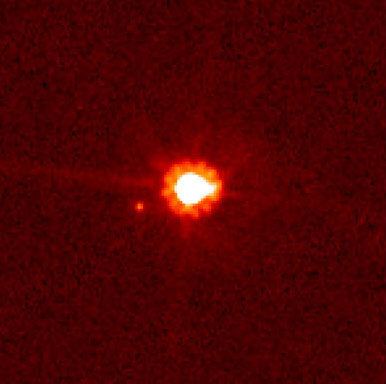Discovery date September 10, 2005 Adjectives Dysnomian | Alternative names S/2005 (2003 UB313) 1 | |
 | ||
Discovered by Michael E. Brown, M. A. van Dam, A. H. Bouchez, D. Le Mignant, R. D. Campbell, J. C. Y. Chin, A. Conrad, S. K. Hartman, E. M. Johansson, R. E. Lafon, D. L. Rabinowitz, P. J. Stomski Jr., D. M. Summers, C. A. Trujillo, and P. L. Wizinowich Pronunciation /dɪsˈnoʊmiə/ or /daɪsˈnoʊmiə/ | ||
Dysnomia (Greek: Δυσνομία)—officially (136199) Eris I Dysnomia—is the only known moon of the dwarf planet Eris (the most massive known dwarf planet in the Solar System). It was discovered in 2005 by Mike Brown and the laser guide star adaptive optics team at the W. M. Keck Observatory, and carried the provisional designation of S/2005 (2003 UB313) 1 until officially named Dysnomia (from the Ancient Greek word Δυσνομία meaning anarchy/lawlessness) after the daughter of the Greek goddess Eris.
Contents
Discovery
During 2005, the adaptive optics team at the Keck telescopes in Hawaii carried out observations of the four brightest Kuiper belt objects (Pluto, Makemake, Haumea, and Eris), using the newly commissioned laser guide star adaptive optics system. Observations taken on 10 September revealed a moon in orbit around Eris, provisionally designated S/2005 (2003 UB313) 1. In keeping with the Xena nickname that was already in use for Eris, the moon was nicknamed "Gabrielle" by its discoverers, after Xena's sidekick.
Properties
Dysnomia was found 4.43 magnitudes fainter than Eris, and its diameter is estimated to be between 350 and 490 km, though Mike Brown claims that it is 500 times fainter and between 100 and 250 km in diameter. It is 60 times fainter than Eris in the K band and 480 times fainter in the V band, which means a very different, and quite redder, spectrum, indicating a significantly darker surface. Assuming its albedo is five times lower than Eris's, its diameter would be 7005685000000000000♠685±50 km, meaning that Dysnomia is itself likely a rather large Trans-Neptunian object. Of the Solar System's dwarf planet and minor planet moons, only Charon is definitely larger than Dysnomia.
Combining Keck and Hubble observations, the satellite was used to determine the mass of Eris, and orbital parameters were estimated. Its orbital period is calculated to be 7001157740000000000♠15.774±0.002 d. These observations indicate that Dysnomia has a circular orbit around Eris, with a radius of 7007373500000000000♠37350±140 km. This shows that the mass of Eris is 1.27 times that of Pluto.
Formation
Astronomers now know that the four brightest Kuiper belt objects (KBOs) have satellites. Among the fainter members of the belt only about 10% are known to have satellites. This is thought to imply that collisions between large KBOs have been frequent in the past. Impacts between bodies of the order of 7006100000000000000♠1000 km across would throw off large amounts of material that would coalesce into a moon. A similar mechanism is thought to have led to the formation of the Moon when Earth was struck by a giant impactor early in the history of the Solar System.
Name
Mike Brown, the moon's discoverer, chose the name Dysnomia (Greek: Δυσνομία) due to a number of associations it had for him. Dysnomia, the daughter of Eris, fits the general historically established pattern of naming moons after lesser gods associated with the primary god (hence, Jupiter's largest moons are named after lovers of Jupiter, both male and female, while Saturn's are named after his fellow Titans). Also, the English translation of "Dysnomia", "lawlessness", echoes Lucy Lawless, the actress famous for starring in Xena: Warrior Princess on television. Before receiving their official names, Eris and Dysnomia were nicknamed "Xena" and "Gabrielle", and Brown decided to retain that connection.
Brown also notes that Pluto owes its name in part to its first two letters, which form the initials of Percival Lowell, the founder of the observatory where its discoverer, Clyde Tombaugh, was working, and the person who inspired the search for "Planet X". James Christy, who discovered Charon, followed the principle established with Pluto by choosing a name which shared its first four letters with his wife's name, Charlene. "Dysnomia", similarly, has the same first letter as Brown's wife, Diane, and Brown uses the nickname "Dy" /ˈdaɪ/ for the moon, which he pronounces the same as his wife's nickname, Di. Because of this, Brown pronounces the full name /daɪsˈnoʊmiə/, with a long "y".
